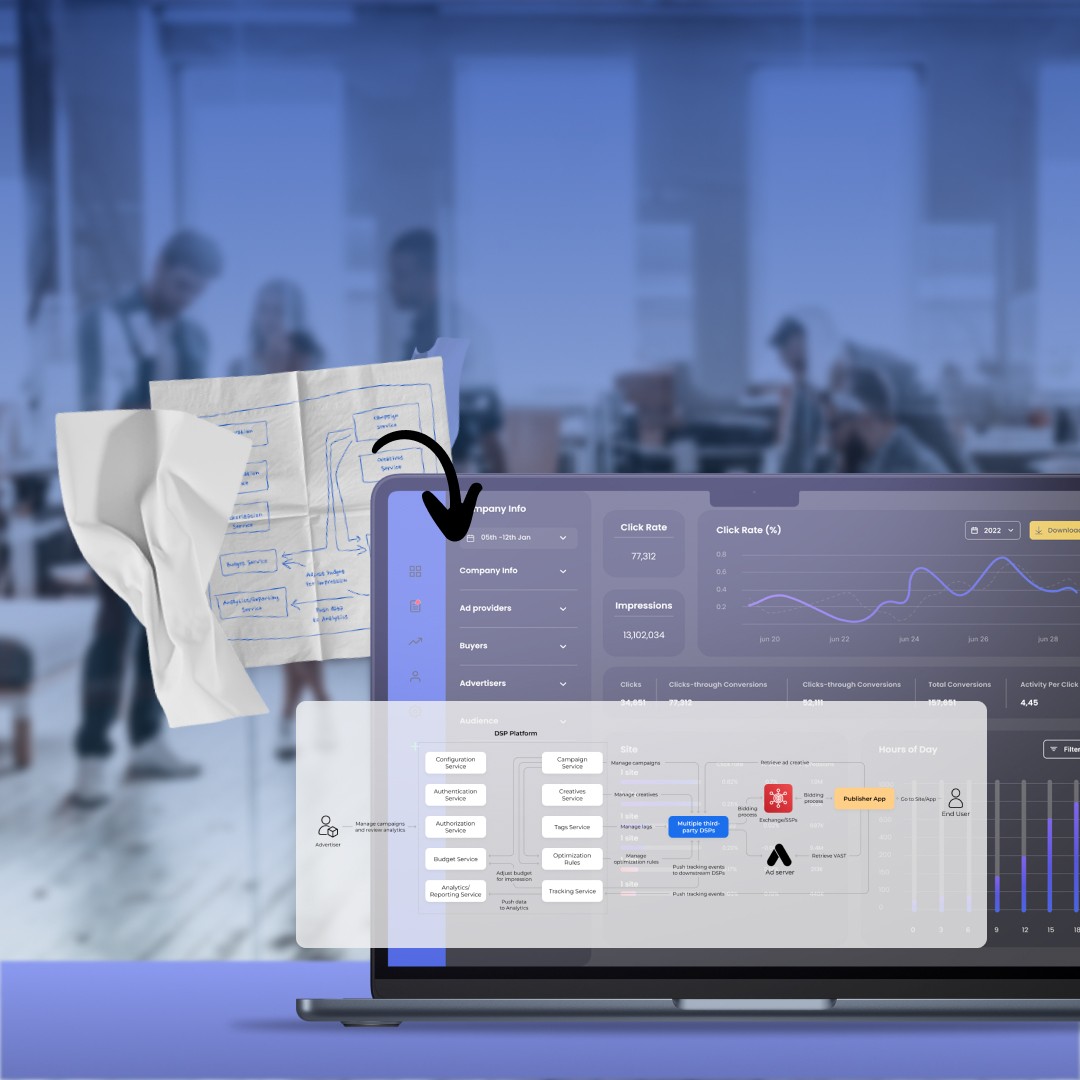Enhancing understanding of header bidding
Welcome to the live broadcast of ad buyers’ and sellers’ business lives! Publishers are actively seeking to pull their ad inventory in a way that brings them the most revenue by maximizing ad inventory yield.
But what of those named advertisers? They can’t stand by, so they’re thoroughly examining fair chances to bid on the desired ad inventory when choice items are available. This is where the trading path known as header bidding is instrumental for both sides.
We will not lie — the concept of header bidding integration might cause confusion at first sight. Its interconnected trails seem like a tangled mess of ideas and steps. But no worries! Oxagile’s AdTech team, with years of hands-on experience in implementing and optimizing header bidding solutions, has gathered those questions wrapped most in mystery around this technology. We stand ready to untangle any knots in understanding, lighting the path ahead with clarity.
So, are you prepared now to “switch to another channel” and explore the universe of header bidding? Let us journey forth together and uncover its riches!
What is header bidding? Cutaway view of the term
The prior question that heats people’s minds sounds quite logical, right? So, first off, let’s set the record straight on the term:
- Basically, header bidding is a programmatic auction framework that publishers can enrich their websites with to make ad inventory sales flow smoothly. Depending on the setup — client-side, server-side, or hybrid &Mdash; it may involve inserting a piece of JavaScript code into the header part of a webpage or routing requests through a server.
- When users’ eyes first find the webpage, the header bidding process begins. It calls out to those who help find the buyers of ad space — these are SSPs (supply-side platforms), a kind of middleman helping to sell ad space. Even before Google Ad Manager or any other ad server joins in, demand partners are already placing their bids and asking, “Who wants to show an ad in this very place, and how much are they willing to pay?”. Unlike traditional setups such as Google header bidding (Open Bidding), this approach enables truly simultaneous, transparent auctions with broader partner access.
- The scene happens faster than two heartbeats, as accessed by publishers. This grants SSPs, DSPs (demand-side platforms), ad exchanges, and ad networks just enough time to react by introducing relevant offers. Thanks to header bidding integration, the entire process becomes more competitive and transparent. The final result is an advanced ad sales process for publishers. Ultimately, publishers trade in a swifter, smarter fashion, with the help of modern header bidding solutions.

But why did header bidding turn into quite a thing in AdTech?
Header bidding emerged in 2014 as a response to the limitations of the traditional waterfall model, which prioritized demand partners sequentially and lacked transparency. The need for more competitive, fair, and efficient programmatic auctions gave rise to this new approach.
Since then, header bidding has evolved into a widely adopted monetization method across desktop, mobile, and CTV platforms. It now plays a key role within the broader real-time bidding (RTB) landscape. According to Grand View Research, the global RTB market was valued at $14.37 billion in 2023 and is projected to reach $16.27 billion in 2024, with a compound annual growth rate (CAGR) of 16.0% through 20301.
These figures underscore the growing demand for more transparent and dynamic auction mechanisms. Header bidding solutions:
- Replace outdated sequential auctions with simultaneous real-time bidding, increasing competition for each impression;
- Enable publishers to access and control bid-level data, including price floors and timeouts;
- Support multiple implementation models — client-side, server-side, or hybrid, aligned with modern privacy, performance, and AI-driven optimization standards.
What began as an experiment has become a cornerstone of programmatic advertising, not just for publishers, but for advertisers seeking premium, high-visibility inventory as well.
Getting down to practice: How header bidding works
Are you ready to witness the bidding process in action? It’s like a perfectly choreographed dance, when everyone moves together in perfect unison. Here is how it flows:
Action 1. A user comes to the publisher’s website, and that’s the starting point where the header bidding magic begins.
Action 2. The publisher’s website loads a wrapper script, either in the browser (client-side) or on a server (server-side or hybrid setup).
Action 3. The wrapper script jumps into action and sends calls to ad exchanges, SSPs, and other demand sources. It’s like saying, “Hey, who wants to bid on these ad spots?” These calls can be executed through the user’s browser or a server, depending on the integration model.
Action 4. All demand sources come back and present their bids, telling you how much they offer to pay per thousand impressions or per click. All hope it’s worth more than others.
Action 5. The wrapper script takes all those bids, seeing which is fairest. Then it asks Google Ad Manager (GAM), which is the ad server, to support with what’s going to be the next step — running a unified auction, where bids from header bidding compete alongside direct deals and other programmatic campaigns.
Action 6. In the unified auction, the header bidding partners’ bids go up against other deals, like programmatic guaranteed or sponsorship. The bidder with the highest bid emerges victorious, getting a chance to show their ad as a prize.

Header bidding process in a nutshell
Disclosing benefits of header bidding: Why is it a savior for publishers and advertisers?
What’s so great for publishers putting trust in header bidding?
- Premium inventory is just a short hop
Header bidding is like winning a direct pipeline to more premium inventory options available and admission to the best ad spots, so advertisers gain far more chances to delight their intended audience on top-notch websites.
- Enhanced targeting
Advertisers are easily tapping into advanced targeting options, for they reach their customers with greater care, getting super specific with demographics, interests, or behaviors. Combined with first-party data strategies and identity resolution tools, header bidding improves precision without relying on third-party cookies.
- Campaign performance has never been so lush
Once advertisers join header bidding auctions, they stand a real chance to win ad spaces at honest market prices. This brings improved campaign performance, higher click-through rates, and better returns on investment.
- Ad fraud faces defeat
Header bidding endeavors to protect advertisers from ad fraud. When bidding directly on inventory and skipping obsolete waterfall setups, advertisers are 100 percent sure that ad impressions are legit and reaching true people. Additional anti-fraud tools, such as sellers.json, ads.txt, and OpenRTB protocols, help validate supply paths and filter out invalid traffic.
- Higher ad viewability also comes
Header bidding unlocks top-tier ad slots that users are much more likely to actually notice. While other advertisers may get chump spots out of sight and mind, header bidding puts the one who uses it front and center.

Advertisers are not left out of the loop either
- Premium inventory is just a short hop
Header bidding is like winning a direct pipeline to more premium inventory options available and admission to the best ad spots, so advertisers gain far more chances to delight their intended audience on top-notch websites. - Enhanced targeting
Advertisers are easily tapping into advanced targeting options, for they reach their customers with greater care, getting super specific with demographics, interests, or behaviors. It’s like having a laser-focused targeting mechanism that guarantees that ads land right in front of the right people, maximizing campaign effectiveness. - Campaign performance has never been so lush
Once advertisers join header bidding auctions, they stand a real chance to win ad spaces at honest market prices. This brings improved campaign performance, higher click-through rates, and better returns on investment. - Ad fraud faces defeat
Header bidding endeavors to protect advertisers from ad fraud. When bidding directly on inventory and skipping obsolete waterfall setups, advertisers are 100 percent sure that ad impressions are legit and reaching true people. No more wasting money on fake traffic. - Higher ad viewability also comes
Header bidding unlocks top-tier ad slots that users are much more likely to actually notice. While other advertisers may get chump spots out of sight and mind, header bidding puts the one who uses it front and center.
Uncertain about the advantages of header bidding for you?
We’re here to alleviate any confusion and share some expert tips, tailor-made just for your business!
How to implement header bidding: Components you shouldn’t neglect
To enable the accurate setup of header bidding technology to make it work its magic, certain key players must come together in harmony.
Let us now explore the header bidding adapters and wrappers, two strong currents that predetermine header bidding’s path. They ensure a smooth joining of hands between all who would dance in the auction circle. Through them, sellers and buyers find each other’s rhythms without friction.
When adapters and wrappers work as one, the auction dance is joyful and fruitful for all parties.
We’re going to talk about the intricacies of these components and discover the best-selling and influential examples.
Header bidding adapter: What’s it like?
Is it your intention to implement header bidding? If so, the header bidding adapter plays a key role. It serves as the messenger, carrying words between buyers and sellers to make the trade flow and the kaleidoscope of ad requests and bids go smoothly.
The adapter does more than merely deliver messages, thus connecting publishers and demand partners. It also sends out calls for bids and interprets the responses from sellers. This allows all to hear the value of the bid and ensure a flawless transition of info to the ad server.
To use header bidding’s power, publishers need strong ties with SSPs, so trade can flourish. There are two trails to build the ties:
- The first is to possess an adapter specifically for each partner. This personal concept ensures messages pass clearly between them.
- The second is to use one adapter that speaks to all partners at once. Though less personal, this simplifies managing trades and lets publishers’ words reach more ears.
By deciding on the proper trail, publishers can augment what they gain from trades and let their businesses prosper through header bidding markets. The adapter helps the deals flow for the sake of each party’s convenience.
Another indispensable element is the header bidding wrapper
One more detail that makes header bidding strong is the header bidding wrapper. At the center of any trading path that bears fruit lies this container that helps all work as one.
p>The wrapper brings together the messengers so trade can flow freely. Without its help, each seller would need to talk with buyers separately, slowing things down and lessening what can be gained. Put simply, the wrapper speeds up the accumulation of bids from demand partners and the whole trading procedure.
In modern implementations, wrappers also handle essential logic for auctions, user ID modules, price flooring, analytics, and GDPR/CCPA consent management.
And there is more to come in terms of wrappers’ power. For those publishers who watch over their consent management activities, it eases the work by eliminating the need to deal with each bidder’s consent individually. No more drowning in a flood of tasks and wasting time. Publishers can guide consent management with less effort and ensure compliance with ease if they rely on the wrapper.

How the liaison between adapters and wrappers looks
There is a vast deal of wrappers to help header bidding work, each with their own gifts. Among them is Prebid.js, the header bidding wrapper that has gained widespread acceptance across the trading paths.
Server-side versions like Prebid Server and hybrid setups are also widely used, especially or mobile and CTV environments.
Others include:
- Proprietary wrapper solutions
- Managed wrapper solutions
What makes Prebid’s wrapper strong in the eyes of ad players?
This open-source JavaScript library carries many proven pre-built adapters for ad networks, ready to be shared. It supports both client-side and server-side header bidding setups via Prebid.js and Prebid Server, providing flexibility across desktop, mobile, and CTV environments.
Its API also makes the integration with custom bidders an easy path. In addition, Prebid offers modules for identity resolution, analytics, GDPR/CCPA compliance, and price flooring, making it a comprehensive header bidding integration framework trusted by thousands of publishers worldwide.
Prebid is widely regarded as the industry-standard open-source solution for header bidding, with broad adoption across leading publishers and ad tech providers.
Its modular architecture allows publishers to activate only the components they need, from identity modules and multi-currency support to native and video formats.
With Prebid Server, publishers can extend header bidding to mobile apps and connected TV (CTV), enabling server-side auctions that reduce latency and improve scalability.
What about the peculiarities of other wrapper options?
Each wrapper has its own gifts to share.
Proprietary wrappers are usually owned by major SSPs, ad exchanges, or media platforms, and are offered to publishers as part of a broader monetization service, often with embedded business conditions or preferred partner biases. While they may offer performance advantages and native integrations, concerns remain around transparency, auction neutrality, and long-term flexibility.
Many publishers remain cautious about adopting proprietary wrapper solutions, particularly when control over auction logic, bidder prioritization, or revenue attribution is unclear. Some solutions also impose technical or volume thresholds, which can limit access for smaller publishers.
Managed wrapper solutions, by contrast, aim to support publishers of all sizes, regardless of technical expertise or existing demand relationships. Typically built on Prebid’s open-source foundation, they provide additional services such as implementation support, account management, ad operations consulting, real-time analytics dashboards, and integration with key modules like identity resolution and consent frameworks.
With managed wrappers, publishers can accelerate time to value while maintaining transparency and control over auction behavior. They’re particularly useful for teams lacking internal dev resources or needing help scaling server-side header bidding.
Wrapping up
All publishers or advertisers who care about gaining value from their ad trades can hardly ignore the impact of header bidding technology. The number of AdTech businesses embracing this trading path continues to grow rapidly, as header bidding becomes a cornerstone of transparent, high-yield programmatic strategy. Those who don’t adapt risk falling behind in both performance and revenue.
At Oxagile, we’re here to help you navigate the full spectrum of header bidding integration — from selecting the right wrapper solution to optimizing auction mechanics and aligning with privacy regulations. We’ll walk you through adapter setup, identity management, analytics tracking, and deployment models tailored to your business.
Whether you’re exploring client-side, server-side, or hybrid implementations, we’re ready to support you in unlocking the full potential of modern header bidding.
Are you keeping any questions in mind now as your company considers all possible ways to implement header bidding in your business? Oxagile is eager to share our AdTech knowledge and help you prosper.
Sources:
1) Grand View Research — Real-Time Bidding Market Size, Share & Trends Analysis Report By Auction Type, By Ad Format, By Application, By Region, And Segment Forecasts, 2023 — 2030.
























